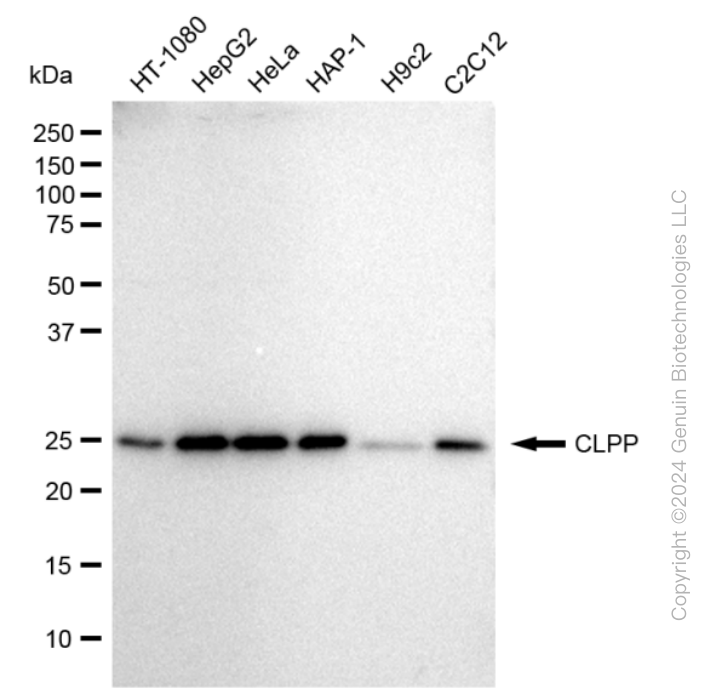KD-Validated Anti-CLPP Rabbit Monoclonal Antibody
Rabbit monoclonal antibody
- SPECIFICATION
- CITATIONS
- PROTOCOLS
- BACKGROUND

Application
| WB, FC, ICC |
|---|---|
| Primary Accession | Q16740 |
| Reactivity | Rat, Human, Mouse |
| Clonality | Monoclonal |
| Isotype | Rabbit IgG |
| Clone Names | 23GB 1865 |
| Calculated MW | Predicted, 30 kDa, observed, 26 kDa |
| Gene Name | CLPP |
| Aliases | CLPP; Caseinolytic Mitochondrial Matrix Peptidase Proteolytic Subunit; ATP-Dependent Clp Protease Proteolytic Subunit, Mitochondrial; Endopeptidase Clp; EC 3.4.21.92; ClpP (Caseinolytic Protease, ATP-Dependent, Proteolytic Subunit, E. Coli) Homolog; ClpP Caseinolytic Peptidase, ATP-Dependent, Proteolytic Subunit Homolog (E. Coli); ClpP Caseinolytic Protease, ATP-Dependent, Proteolytic Subunit Homolog (E. Coli); ClpP Caseinolytic Peptidase, ATP-Dependent, Proteolytic Subunit Homolog; ClpP Caseinolytic Protease, ATP-Dependent, Proteolytic Subunit Homolog; Putative ATP-Dependent Clp Protease Proteolytic Subunit, Mitochondrial; ATP-Dependent Protease ClpAP (E. Coli), Proteolytic Subunit, Human; ClpP Caseinolytic Peptidase ATP-Dependent, Proteolytic Subunit; ATP-Dependent; Protease ClpAP, Proteolytic Subunit, Human; DFNB81; PRLTS3 |
| Immunogen | A synthesized peptide derived from human CLPP |
| Gene ID | 8192 |
|---|---|
| Other Names | ATP-dependent Clp protease proteolytic subunit, mitochondrial, 3.4.21.92, Caseinolytic mitochondrial matrix peptidase proteolytic subunit {ECO:0000312|HGNC:HGNC:2084}, Endopeptidase Clp, CLPP (HGNC:2084) |
| Name | CLPP (HGNC:2084) |
|---|---|
| Function | Protease component of the ClpXP complex that cleaves peptides and various proteins in an ATP-dependent process. Has low peptidase activity in the absence of CLPX. The ClpXP complex can degrade CSN1S1, CSN2 and CSN3, as well as synthetic peptides (in vitro) and may be responsible for a fairly general and central housekeeping function rather than for the degradation of specific substrates (PubMed:11923310, PubMed:15522782). Cleaves PINK1 in the mitochondrion (PubMed:22354088). |
| Cellular Location | Mitochondrion matrix |
| Tissue Location | Detected in liver (at protein level). Predominantly expressed in skeletal muscle. Intermediate levels in heart, liver and pancreas. Low in brain, placenta, lung and kidney |

Thousands of laboratories across the world have published research that depended on the performance of antibodies from Abcepta to advance their research. Check out links to articles that cite our products in major peer-reviewed journals, organized by research category.
info@abcepta.com, and receive a free "I Love Antibodies" mug.
Provided below are standard protocols that you may find useful for product applications.
If you have used an Abcepta product and would like to share how it has performed, please click on the "Submit Review" button and provide the requested information. Our staff will examine and post your review and contact you if needed.
If you have any additional inquiries please email technical services at tech@abcepta.com.














 Foundational characteristics of cancer include proliferation, angiogenesis, migration, evasion of apoptosis, and cellular immortality. Find key markers for these cellular processes and antibodies to detect them.
Foundational characteristics of cancer include proliferation, angiogenesis, migration, evasion of apoptosis, and cellular immortality. Find key markers for these cellular processes and antibodies to detect them. The SUMOplot™ Analysis Program predicts and scores sumoylation sites in your protein. SUMOylation is a post-translational modification involved in various cellular processes, such as nuclear-cytosolic transport, transcriptional regulation, apoptosis, protein stability, response to stress, and progression through the cell cycle.
The SUMOplot™ Analysis Program predicts and scores sumoylation sites in your protein. SUMOylation is a post-translational modification involved in various cellular processes, such as nuclear-cytosolic transport, transcriptional regulation, apoptosis, protein stability, response to stress, and progression through the cell cycle. The Autophagy Receptor Motif Plotter predicts and scores autophagy receptor binding sites in your protein. Identifying proteins connected to this pathway is critical to understanding the role of autophagy in physiological as well as pathological processes such as development, differentiation, neurodegenerative diseases, stress, infection, and cancer.
The Autophagy Receptor Motif Plotter predicts and scores autophagy receptor binding sites in your protein. Identifying proteins connected to this pathway is critical to understanding the role of autophagy in physiological as well as pathological processes such as development, differentiation, neurodegenerative diseases, stress, infection, and cancer.





